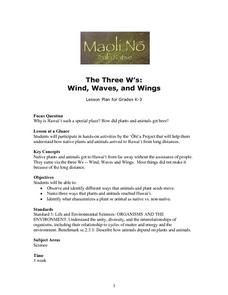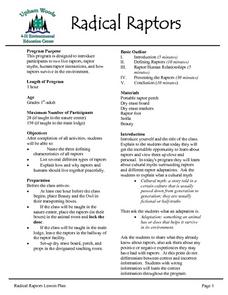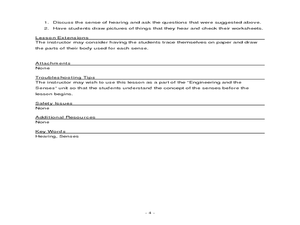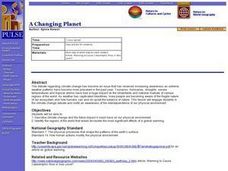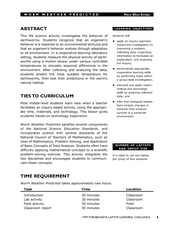Curated OER
Food Webs
Learners research an animal to define its food web and life cycle. For this animal life cycle lesson, students research an animal and define its food web. Learners then present their animal food webs to the class and note other animals...
Curated OER
Oh Deer!
Students discuss the components necessary to keep animal populations alive . Then they participate in a game where they interact as deer, food, water, and shelter. The activity demonstrates that nature is not static, but changes with the...
Curated OER
The Three W's: Wind, Waves, and Wings
Students participate in hands-on acticities to understand how native plants and animals arrived on Hawaii from long distances without the assistance of man. They then identify what characterizes a plant or animal as native vs. non-native.
Curated OER
Chick Embryology
Students investigate techniques that can be used to observe the development of the chick embryo. They explore the environment in which the chick develops and how it can be manipulated.
Curated OER
Waltz Across Texas
Seventh graders conduct research about regions of Texas by using the web. They research an endangered plant AND an endangered animal that is found in their region. Students prepare and deliver oral reports about their region.
Curated OER
The Great Koala Rescue
Third graders examine an animal rescue that occurred in Australia by reading an article from National Geographic Kids Online. Individuals practice their non-fiction reading skills and are introduced to new terms as they investigate the...
Curated OER
Radical Raptors
Students are introduced to raptors and their role in the environment. They identify three characteristics of raptors and list several types of raptors found in nature. They discuss their positive and negative experiences with raptors and...
Curated OER
Engineering and the Senses: Hearing
Students explore the sense of hearing. In this 5 senses lesson, students consider how humans and animals use the sense of hearing along with their other senses. Students discuss the body parts responsible for the 5 senses and play the...
Curated OER
Investigating Crickets and Their Body Parts
Second graders investigate the body of a cricket. In this biology lesson students use tools to gain information about the insect the cricket. Students observe and identify features and describe how these features help the cricket live in...
Curated OER
Bringing Up Birdy
Students explore biology by creating diagrams of animal life cycles. In this baby bird lesson, students view video clips of birds being born from incubation to flying on their own. Students utilize the Internet to research birds and...
Curated OER
Natural Figures
First graders look for geometrical shapes in nature to help them appreciate the diversity of the natural environment.
Curated OER
Oceanography
Fifth graders use scientific skills and processes to recognize how living things depend on one another and on the environment for survival and that the human use of natural resources impacts the environment. They research how Earth's...
Curated OER
A Changing Planet
Young scholars describe climate change and the future impact it could have on our physical environment. They identify the regions of the world that would encounter the most significant effects of a global warming.
Curated OER
Lessons from The Lorax
Learners read and watch a video of The Lorax by Dr. Suess. As a class, they answer a set of questions about how the environment was affected by industries. They also brainstorm a list of possible solutions to help curb the pollution.
Curated OER
Worm Weather Predicted
Students examine worm habitats. In this animal habitats lesson, students participate in a lab activity that requires them to explore the adaptations that earthworms make to their environment.
Curated OER
Seabird Survival Adaptation Card Game
Students study seabirds and how they have adapted to their environments. In this activity based instructional activity students will play a card game that will allow them to have a better understanding of seabirds and their adaptations.
Curated OER
Hollow Form - Monsters - Beasties That Never Were
Students investigate Medieval art Gargoyles/Beasties and creatures used for animation films, design an original monster, and create a hollow clay form using hand building techniques.
Curated OER
Stimulus Response
Students explore the five steps in the stimulus-response pathway. They analyze the senses and the difference between animals' primary and secondary senses. Students collect information about animal behavior to debate the ethics of...
Curated OER
Watchable Wildlife Checklist
In this wildlife worksheet, students will read over a list of 28 native animal species, their needs, and interesting characteristics. This list can be used as a checklist when out on a hike or in the school yard to identify common wildlife.
Curated OER
Desert Tortoise Adaptations
Students observe the Desert Tortoise in its natural surroundings. For this adaptations lesson, students study and take pictures of an animal in its habitat, then design a PowerPoint which addresses adaptations, biodiversity, and threats...
Curated OER
The Forest-Life in the Wild!
Students write a description of each animal using their completed outline and include a graphic of the animal for the program, or a hand drawing. Each student chooses and writes about 2 Rain Forest Animals.
Curated OER
Food Web Mystery
Students describe typical marine food webs, and explain why food is generally scarce in the deep-ocean environment. They discuss reasons that seamounts may support a higher density of biological organisms than would appear to be possible.
Curated OER
A Natural Habitat: What, How and Why
Students understand what a habitat is. They determine why a habitat is important to our environment no matter where it is located. Students observe and recognize natural habitats in their surroundings.
Curated OER
Endangered Species 1: Why Are Species Endangered?
Young scholars are oriented to the plight of endangered species and to help them explain and gain perspective on human issues that continue to endanger species and threaten our global environment.




